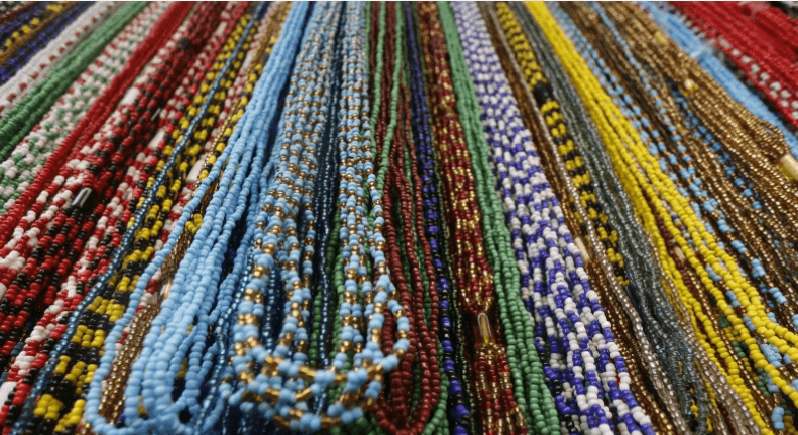Guia Necklaces
By:
Mãe Ju of Obaluaie
On
02/08/2024Reading time:
8 min
Summary:
Guias in Umbanda are spiritual necklaces that protect against negative energy. Made from materials like beads and seeds, they absorb harmful influences and are cleansed in rivers or oceans, reflecting Umbanda's unique spiritual practices.

Ancient Traditions
The use of adornments like necklaces, talismans, and bracelets dates back so far that it's impossible to pinpoint exactly when this practice began. What we do know is that these items have always held significant meaning across various cultures.
In some tribes, these adornments served as protection against animal attacks, negative influences from other worlds, and rival enemies.
Primitive Materials
The first necklaces weren’t made of polished beads like those seen today. Instead, they were crafted from more primitive elements such as animal manes, claws, human hair, and bones—the ancestors of today’s guias (spiritual necklaces).
Even today, some guias are still made with animal teeth, though thankfully human hair is now mostly left out!
Modern Representation
The sight of someone wearing many guias tends to draw attention, often leading to associations with "macumba," a derogatory term for Afro-Brazilian religions. However, as highlighted by Rubens Saraceni in his book Formulário de Consagrações Umbandistas, there is nothing unusual or fetishistic about Umbanda mediums using guias for spiritual protection.
Saraceni also reassures Umbanda practitioners not to feel embarrassed about wearing guias in public. It’s no different than anyone else wearing their religious symbols.
He further draws parallels with other cultures, such as kings and queens who adorned themselves with similar items for protection, or priests who use rosaries as a form of spiritual defense.
Just as people in different religions and tribes use various elements to protect against external influences, Umbanda practitioners use guias for the same purpose. Each belief system, however, offers its own unique explanation for these practices.
Umbanda’s Sacred Rites
The famous phrase “Umbanda has foundations and must be prepared” rings true, especially regarding consecratory rituals. Umbanda has its own sacred rites, working within the religion’s egregore, without needing to replicate the practices of other faiths.
Magical Power of Guias
Guias in Umbanda carry magical foundations, but there is still confusion among some practitioners. Some cling to traditions from Candomblé or other beliefs, ignoring the distinctly Umbandist magic.
There are also those who wear beautifully crafted necklaces in a variety of colors and forms but struggle to explain their meaning. Saraceni addresses this in his book, encouraging Umbandists to feel more pride and confidence in their magical-religious practices, without feeling compelled to adopt the rituals of other traditions.
What Do They Look Like?
Guias are typically made from beads, crystal, rosary beads, seeds like the "eye of ox" (Ox Eye or Mucuna sloanei) and "eye of goat" (Crab's Eye or Abrus precatorius seed), cowries, steel pendants, coconut shells, and more. Some use nylon or cord to thread these items, and the choice of material often comes from personal preference or guidance from a spiritual leader.
Purpose
Guias act as condensers of energy from spiritual guides, absorbing negative accumulations from electromagnetic fields and protecting mediums from harmful influences during rituals. They prevent negative energies from reaching the medium and can also be worn daily as a kind of spiritual "lightning rod," protecting against the heavy energies we all encounter in our daily lives.
Crafting and Care
In Umbanda, guias are often crafted upon the request of a spirit or priest, who provides guidance on their characteristics and purpose. In some cases, a person may feel an intuitive need to create a guia and seek spiritual guidance for its assembly.
Guias must also be regularly “unloaded,” meaning they need to be purified of the negative energies they’ve absorbed. Washing your guias in a river or in the ocean is a traditional and effective way to unload them, allowing the natural currents to cleanse and restore them. The frequency of this cleansing is determined by the guiding entity, and the medium must follow proper procedures to clean their guia.
In his book Manual Doutrinário, Ritualístico e Comportamental Umbandista, Rubens Saraceni offers guidance on the proper care of these sacred items:
- Treat them with respect and care.
- Cleanse them with incense at the start of rituals.
- They should be worn by more experienced mediums or when specifically requested by the spirits.
The White One
In Umbanda, the guia of Oxalá is considered one of the most essential spiritual necklaces for every practitioner. Oxalá, the supreme Orixá of creation, symbolizes purity, peace, and spiritual protection. His guia is traditionally made of white beads, representing these qualities and serving as a spiritual shield.
Wearing the guia of Oxalá connects the wearer to his divine energy, which fosters balance, harmony, and wisdom. It is said that Oxalá governs the head and spiritual well-being, and his guia acts as a conduit for these blessings.
As Oxalá is the father figure and creator in Umbanda, his guia is viewed as foundational. It provides protection against negative energies, promotes spiritual growth, and enhances the connection between the practitioner and the divine.
